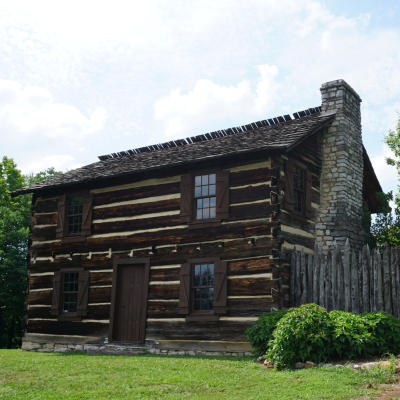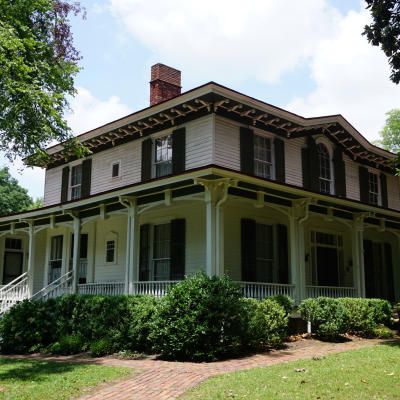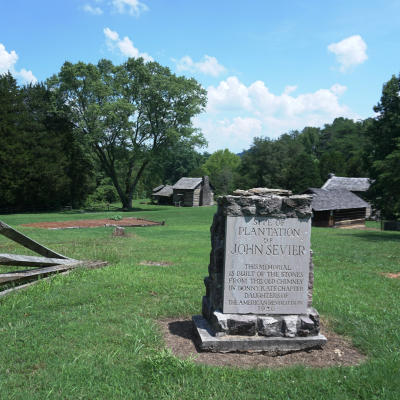In and around Knoxville is an array of photogenic historic homes, houses noted for their age, architecture, and stories of the people who lived there. No two are very much alike. Some have been known and respected as house museums for almost a century, while another is a relatively recent addition. As it happens, few of them are in the same neighborhood, and several are out of the way, and require cars and good directions. But they’re all worth seeing.
Here’s our guide to Knoxville’s Historic House Museums.

Blount Mansion
200 West Hill Avenue (Downtown)
The city’s only certified National Historic Landmark is right in downtown Knoxville. Believed to have been built in 1792, the home of territorial Gov. William Blount has stood on Hill Avenue since before Tennessee was a state. It has an old and credible claim to be the first frame house ever built west of the Appalachians. According to legend, this house with real glass windows, an oddity in this community of log cabins, owes its style to the refined tastes of Mary Grainger Blount, the governor’s wife; the Cherokee are reputed to have dubbed it “the house with many eyes.” The word “Mansion” may surprise first-time visitors. Although it’s dignified, even elegant in style, it’s not a big house, but the word “mansion” became associated with it during the era of its preservation in the early 20th century, probably to emphasize its role as the home of a governor. Already a Revolutionary War veteran and an official signer of the U.S. Constitution, Blount served as chief executive of the U.S. Southwest Territory, representing the George Washington administration on the frontier. He played a leading role in the creation of the state of Tennessee, but he was a complicated man in complicated times. Months after he was chosen one of the state’s first U.S. senators, enemies exposed his complicated plan to make Spanish Louisiana a British territory, resulting in his ejection from the U.S. Senate. Though still under suspicion, Blount regained some stature in his community when he was elected to the state senate. He died here in 1800; Mary, the only woman ever to be honored with the name of a Tennessee county—Grainger County—died two years later. They’re buried two blocks north, at First Presbyterian’s churchyard.
Later the same house was the home of a family of Knoxville leaders, notably Mayor Samuel Beckett Boyd, and still later still it was the childhood home of prolific photographer James Thompson. Neglected for a time and almost demolished for a hotel parking lot, the house was the subject of a vigorous effort led by women in 1925 to save it as a historic site. For almost a century, it has served Knoxville as a locale for tours, lectures, parties, and other special events. The grounds, which comprise an interpretive center for lectures and gardens, also include Blount’s personal office, in a separate building, which is believed to be where Tennessee’s first constitution was drafted, and a recreation of the Blount’s kitchen, equipped as it would have been in the 1790s.
Typical annual events include Statehood Day, Christmas Open House, Days of Dread, and various lectures and other events throughout the year.
See https://blountmansion.org/ or call (865) 525-2375. Tours of the house are $10, with discounts for children and seniors.
 Crescent Bend
Crescent Bend
2728 Kingston Pike (about two miles west of downtown)
Barely west of UT campus is the historic residential section of Kingston Pike, which is lined with big trees and dozens of historic houses, many of them more than a century old, but the oldest by far is Crescent Bend, completed in 1834. Built for one of Knoxville’s few large-scale planers, Drury Paine Armstrong (1799-1856), who was also a civic leader and early supporter of the university. He and his wife Ann Amelia Houston lived here with their family, who resided in the house for more than 60 years. During the unsuccessful Confederate siege of Knoxville in 1863, it was occupied for several days by Confederate Gen. Joseph B. Kershaw, probably the closest military headquarters to Union lines.
With other owners, the house went through several changes. Around the turn of the century, an owner tried to make it a Victorian-style house, with porches and a corner turret. In the 1920s, a later owner reversed those changes to return it to the federal style known to the Armstrongs. It has been a museum house and event space since 1976.
Perhaps Knoxville’s most elegant museum home, Crescent Bend displays a collection of antique English silver, some of it dating to the 1600s, and is known for its storied Jacksonian-era wallpaper in one room, and its terraced gardens cascading down to the river.
Crescent Bend is currently open only on Friday from 10 to 4, and Saturday from 10 to 1. See http://www.crescentbend.com/ or call 865-637-3163.
 James White’s Fort
James White’s Fort
205 East Hill Avenue (Downtown)
"Knoxville's First Home" is a restoration of James White's twice-moved log cabin, within an educated reconstruction of a 1780s-style fort like the one established in 1786 by North Carolina-born Revolutionary War veteran and pioneer James White (1747-1821), who has long been regarded as Knoxville’s founder, the first permanent settler in what we know as downtown. This reconstruction, an evocation of 1780s frontier life completed for visitors in 1970, is arguably historic in itself, more than half a century old and the site of hundreds of memorable events.
The original James White cabin, fort, and mill was about 1,500 feet to the northwest, near what’s now First Presbyterian Church, which White helped establish. His original cabin, almost forgotten as such, was incorporated into other structures before 1906, when a preservationist recognizing its value moved it to a suburban neighborhood on Woodlawn Pike in South Knoxville. There it stood for almost 60 years, as a rather unusual-looking residence, until a movement in the late 1950s to revive White’s heritage prompted an effort to move the original timbers remaining in the South Knoxville home to be reassembled as part of the James White Fort project. That cabin stands on the south side of the fort. The compound contains furniture and personal items, some of which are known to have belonged to White himself.
Special events are held throughout the year including Knoxville Homecoming, Junior Docent Day, Statehood Day, HearthScares Ghost Tours of Downtown Knoxville, Annual Halloween Bash, and Christmas Open House.
Open Mon.-Sat., 9:30-5:00 (reduced hours in winter) Guided tours are $10, with discounts for children and seniors. See https://www.jameswhitesfort.org/ or call (865) 525-6514.

Mabry Hazen House
1711 Dandridge Avenue (about one mile east of downtown)
This graceful wooden house—built in the late 1850s, it’s barely antebellum, with an Italianate design—is appealing on its own, on a hilltop long famous for its views, has become more famous for its dramatic stories, both scandalous and tragic. Original builder Joseph Mabry, the impetuous businessman who in 1854 led the creation of downtown’s Market Square, was known to go armed, and was known to have shot at least one man, a prominent politician, long before his role in East Tennessee’s most infamous gunfight. In 1881, one of his sons who had lived in this house was killed in a saloon gunfight, and some historians believe that was a factor in the still-unknown motive for that happened on Oct. 19, 1882, when Mabry and another son both died in another gunfight with banker Thomas O’Conner in front of the Mechanic’s Bank on Gay Street. O’Conner was also killed, and this extraordinary triple fatal shooting in which all three combatants were killed elicited national headlines, and the attention of Mark Twain, who commented on it in his book, Life on the Mississippi.
It was not the last time residents of this house received unwanted national publicity. Almost 50 years later, Mabry’s granddaughter, Evelyn Hazen, was the plaintiff in a sexually lurid breach-of-promise lawsuit that, not unlike her forebear’s exploits, earned national headlines. The eccentric former teacher lived here, mostly alone, for the rest of her life, and after her death in 1987, her will established the family home as a museum, with a broad lawn that is often a site for parties and weddings. The house’s interior is especially well-preserved, with beautiful marble mantels and much of the Mabrys’ original furniture. Hosts are not shy about telling the full stories of the people who lived there.
Typical annual events include Statehood Day, Stories of Emancipation Tours, Fourth of July on Mabry’s Hill, Victorian Seances, Christmas Open House, and several Night at the Museum events throughout the year.
See mabryhazen.com, or call (865) 522-8661. Tours of the house are $10, with discounts for children and seniors.

Marble Springs
1220 West Governor John Sevier Highway (about six miles south of downtown)
Wholly different from all the other Historic House Museums, Marble Springs is the old John Sevier homeplace, a rustic farm site with a collection of historic log cabins including a small tavern and a smokehouse. The property, once comprising hundreds of acres, was the last home of the Virginia-born pioneer and Revolutionary War leader who became the first governor of Tennessee in 1796. Never a homebody, the 70-year-old Sevier was a U.S. congressman on a surveying expedition in the pre-Alabama wilderness in 1815 when he died. Though many details of his personal life are speculative, he made a gesture toward building a house in downtown Knoxville when the town was the state’s capital, but is known to have kept a home here off and on from about 1790 until his death, and most of these cabins are very old, arranged to suggest several aspects of Sevier’s era, including a stout cabin on the site long believed to be Sevier’s own home, and the subject of much interest at the time of its discovery and restoration by a state campaign in 1941, has since been determined to have been built later, probably about 20 years after Sevier’s death. However, that 1835 date in itself makes it one of the area’s oldest intact log cabins on its original site. The site is valuable partly as a quiet place in the woods—the 34-acre site, a clearing by a brook, is a certified wildlife habitat, closed in by woods—and as a picturesque recreation of pioneer life.
Typical annual events include Statehood Day, Easter Egg Hunt, and night sky watching.
Marble Springs is open Wed.-Sat., 10-5, and Sunday 12-5. Self-directed tours are free, but guided tours are $10 for adults, with discounts for students and children. See marblesprings.net, or call (865) 573-5508.

Ramsey House
2640 Thorngrove Pike (East Knox County, almost seven miles east of downtown)
Ramsey House, on a rural site of more than 100 acres sometimes known as Swan Pond, dates to 1797, making it one of the oldest houses of any kind in the Knoxville area, but it’s especially historic for its rare construction. Designed by English-born and trained architect Thomas Hope, it’s believed to be the first structure ever built of Tennessee marble, which later became famous for its use on public buildings across America. It was originally the home of Pennsylvania-born Francis Alexander Ramsey, a prominent civic leader of early Knoxville, and of his high-achieving sons, notably J.G.M. Ramsey, a physician and author who became one of Tennessee’s first state historians, and William B.A. Ramsey, who was elected mayor of Knoxville, and later served in several statewide offices. The out-of-the-way house was half-forgotten and obscure to most Knoxvillians until the Daughters of the American Revolution placed a plaque on it in 1927; the Association for the Preservation of Tennessee Antiquities purchased it in 1952, and began celebrating it with events and exhibitions. Its furniture is from the Ramsey period, including Chippendale chairs that belonged to the family.
In recent years, hundreds of people have come to know the Ramsey House grounds as a vintage “Base Ball” field, where historians and lovers of extreme sports join together to play 1860s-style, no-gloves “base ball” (it was two words back then). Today, local teams of the Tennessee Vintage Base Ball Association (Emmett Machinists and the Holstons) face off against visiting teams playing the game as it was played then.
Other typical annual events include various Appalachian craft workshops, the Annual Ancient Sounds Festival of Celtic and Appalachian Music, and the Christmas Marketplace.
Attending base ball games is free. Tours of the house are $10, with discounts for children and seniors. See ramseyhouse.org, or call (865) 546-0745.

Historic Westwood
3425 Kingston Pike (about 2.5 miles west of downtown)
Some historic homes are typical for their era in architecture, but a few were extraordinary even in their day. Westwood is the “newest” of Knoxville’s homes, and when it was completed in 1890, newspaper stories described the elaborate high-Victorian house and especially its most unusual feature—the largest room in the house was the personal studio of an artist, Adelia Armstrong Lutz (1859-1931). The granddaughter of Drury Paine Armstrong, of Crescent Bend, she was unlike most society heiresses in that before her marriage she made a name for herself in art, studying at the Corcoran in D.C., and in Paris during the impressionist era, to impress crowds at several American exhibitions. Her new husband, insurance executive John Edwin Lutz, was eager to encourage her artistic side, and though she bore two children and raised them here, she also kept painting, and occasionally showing her work, though her subjects were often domestic, portraits of her children and of flowers in her yard, especially the hollyhocks for which she became known. The house, designed in the extravagant Richardsonian style by Bauman Brothers, was a model home in its time, and still eye-catching from Kingston Pike. The serpentine wall in front was added in the 1920s, when the pike, once a quiet country road, was becoming a noisy automobile thoroughfare. Adelia’s descendants occupied the house until the early 21st century, when it was restored by the charitable Aslan Foundation. It’s unique among Knoxville’s Historic House Museums in that it’s a daily workplace as the headquarters of Knox Heritage, the large and influential regional preservationist nonprofit, which holds occasional events here. Knoxville’s newest historic home, it has been open to tours only since 2014.
Westwood is open to the public, with hourly tours on Tuesdays and Thursdays 10-4, and Saturdays 10-2. Tours are $10 per person. See https://knoxheritage.org/westwood/ or call (865) 523-8008.

